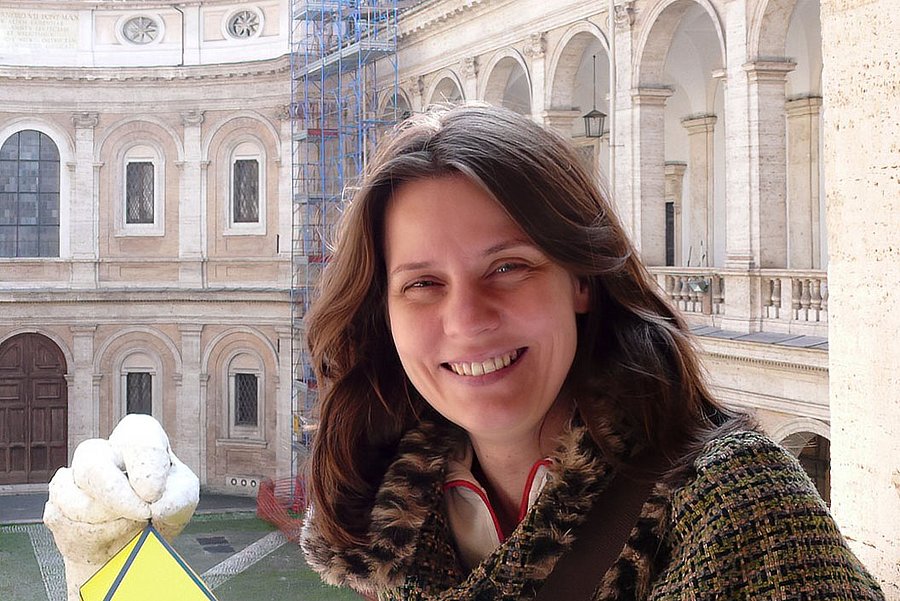
The architectural sculptures of the Barmer city hall
Dr. Doris H. Lehmann / Art History
Photo: Private
The architectural sculptures of the Barmer representative building
On April 23, 1921, the Barmer City Hall was inaugurated
A 100-years-ago-interview with Dr. Doris H. Lehmann from the School of Art and Design at the University of Wuppertal
At the beginning of the 20th century, plans were made for a large town hall in Barmen. It was to be larger than the town hall in Elberfeld, which was inaugurated in 1900. The First World War delayed the construction work, so that the Barmen town hall could not be inaugurated until April 23, 1921. The building was constructed in a neoclassical style. How can you tell?
Lehmann: You can recognize the neoclassical style if you look closely at the facade of the representative building. Here, the staircase leading to the building with the flanking sculptures, the facade division by columns and the crowning attic with figures standing on it evoke associations with ancient or classicist building forms. This differs recognizably from, for example, neo-Gothic town halls, which took medieval models.
The design and the combination of forms at the Barmer Rathaus are antique in a way that betrays their emergence after 1900: in order to emphasize the regularity of the building, decorations that overplay boundaries were dispensed with. The selected architectural dignity formulas clearly order the front side horizontally and vertically. Untypical of an ancient building structure are the colossal columns supported by pairs of columns across the floors. This was not required by the building's use as a town hall, but by its function as a representative building.
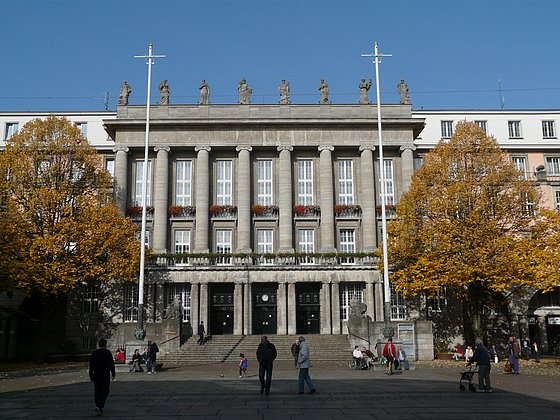
The Dresden sculptor Richard Guhr designed architectural sculptures for the house, which were executed by the sculptor Heinrich Ostlinning from Barmen. What are architectural sculptures?
Lehmann: Architectural sculptures are figurative works of art that complement and decorate an architectural structure. In the case of Barmer Rathaus, the architectural sculptures not only serve decorative purposes, they also convey the function of the building in a representative way and place it in a larger context.
Eight of these figures decorate the attic. The models represent the tasks of the municipalities, i.e. welfare, general administration, civil engineering, legal care, health care, building construction, financial administration and school administration. The preferred material was mostly limestone or sandstone. Is this the best material to work with?
Lehmann: Sandstone is indeed very widespread in Germany as a building material because it is very well suited for processing. However, its popularity is also related to the fact that this ashlar is more readily available than other types of stone due to local quarrying. Sandstone has good durability, although there are technical differences depending on its composition. Limestone, on the other hand, is one of the very strong ashlars, and is therefore valued for its strength. Its resistance to frost offers advantages to builders and architects, especially for outdoor use.
The figures appear very antique and opulent in their garb, haircuts and sometimes luxuriant beards. Why were they depicted in this way?
Lehmann: The Attica figures were intended to fit stylistically with the architecture, which is why they were also designed in an antique style. Their mode of representation is inspired by classical sculptures: the health care system is in the tradition of ancient Asclepius statues. This explains the hair and beard costume, as well as the staff with the snake coiled around it. In the case of the Attica figures, we must remember that their legibility is directly linked to their task on the building: they must be recognizable from a distance and from below. In addition, they stand in each case in an axis with the columns, to which they must fit proportionally. The antique garb corresponds to the overall concept of the classically influenced representative effect. A detail such as a billowing robe is not aimed at opulence, but should give the corresponding figure a dignified appropriate degree of movement.
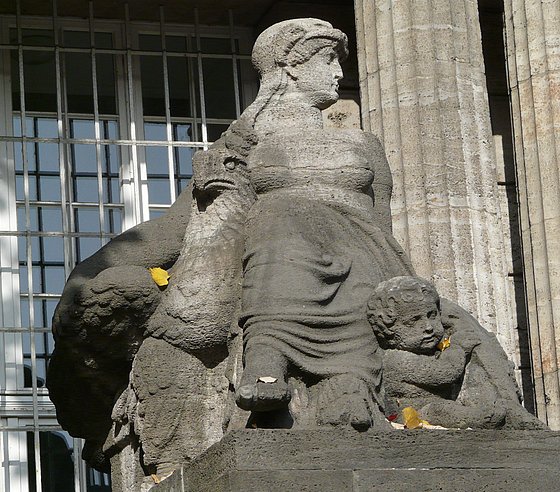
Rhenania / Photo: Jan Nico Kirschbaum
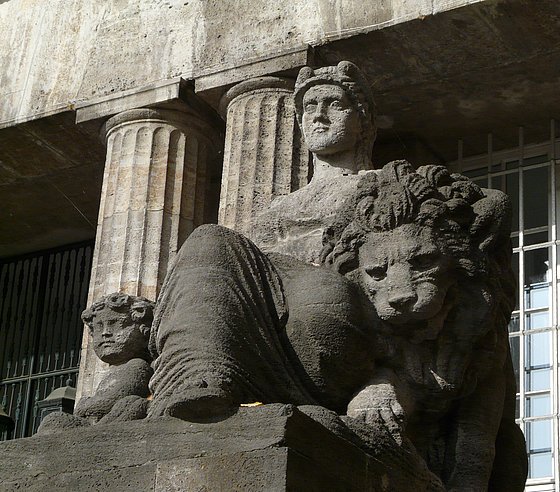
Barmenia / Photo: Jan Nico Kirschbaum
The two female figures flanking the large flight of steps leading to the main entrance, which on the one hand represent the "Rhenania", symbolizing Barmen's affiliation with the Prussian Rhine Province, and the "Barmenia", representing the city of Barmen, are also crafted in this style. Do such mighty sculptures traditionally belong to this type of monumental art, which is not only meant to be eye-catching, but also to demonstrate power?
Lehmann: In practice, it is consistent to combine monumental architecture with colossal figures and to ensure stylistic consistency. If the architecture and its sculptures do not fit together, for example if the figures were too small in proportion, then they could appear ridiculous. In the case of the Barmer Rathaus, this consideration probably also included the design of the square and thus also the Bismarck monument already located there, which was moved for the new building.
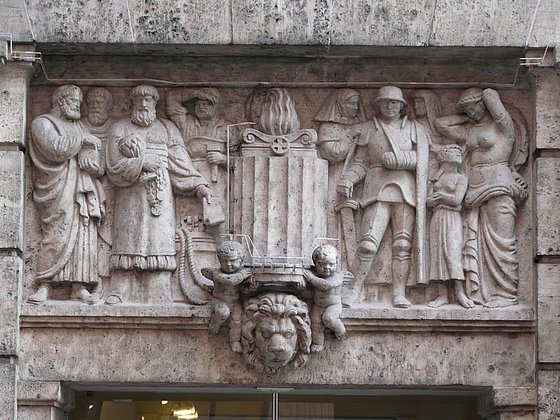
Another relief, again designed by Richard Guhr and this time executed in shell limestone by the sculptor Georg Kauper from Barmen, was placed above the side entrance on Wegnerstraße. The relief shows, among other things, a lion's head, putti, a wounded soldier, a young girl, two nuns, and several scholars. A flame on a pedestal, with an Iron Cross on its bowl, is the focal point. An ensemble with an abundance of symbols. How important are symbols in sculptural art?
Lehmann: Symbols are suitable for plastic representations in order to be able to refer to complex contents in a simplified way and without explanatory words. However, the visual language is also variable depending on the addressee and context, so a symbol can have different meanings. For the Barmer City Hall, local-specific and then-relevant references were probably incorporated. The pride in nursing fits with the commitment to this field at the time.
On the west side of the town hall, at the now closed entrance at the Heubruch, there is a bronze figure by Paul Wynand, a sculptor from Elberfeld who also studied under Auguste Rodin. The figure, which used to be gilded, symbolizes the textile industry, which was so important for Barmen. The filigree female figure stands out clearly against the pink paint of the building's facade. Were these sculptures actually fixed commissions, or was the intention simply to engage renowned artists who then created sculptures with artistic freedom?
Lehmann: We cannot assume artistic freedom for a publicly representative facade as a realistic commission scenario for the time around 1920. Even Rodin did not have this freedom. To this day, public commissions are not an area of work in which visual artists can do as they please. There are well-known cases in which there were disputes between public clients and artists whose artistic independence was taken as an affront because specifications were not adhered to. We have to assume that in the case of the sculptures for the facade design of the Barmer city hall, tasks to be fulfilled were defined. Presumably, the commissions were put out to tender, which could also have been done within the framework of a limited competition. Various artists are likely to have submitted designs, which were then decided on by a commission, which then decided on the awarding of the contract and could also demand changes if necessary. Depending on the complexity of the administration, the matter had to go through various committees. If files and letters on these commissions have been preserved, they could answer such questions as historical sources.
The bronze bases of the two flagpoles on the town hall square are also by Paul Wynand. In the detailed view you can also see a soldier with steel helmet, who is otherwise naked. Why are many sculptures often only lightly skirted or even naked, when the time in which they were created was very prudish?
Lehmann: These figures, raised high from the relief ground, show an "ideal nudity". The absence of clothing is their costume, making the male appearance recognizable as heroic. The nudity points to a supra-temporal meaning and a larger context. This kind of nudity could be legitimized by a tradition going back to antiquity.
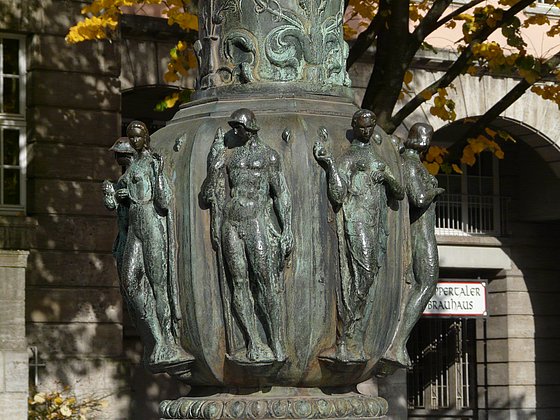
Uwe Blass (Interview on January 25, 2021)
Dr. Doris H. Lehmann is a trained photographer and studied art history, classical archaeology, provincial Roman archaeology and Latin philology at the University of Cologne, where she received her doctorate in 2005. In 2018, she habilitated at the Rheinische Friedrich-Wilhelms-Universität Bonn with a thesis on the strategies of dispute of visual artists in the modern era and has been a private lecturer since then. Since October 2018, she has been teaching art history as a research associate at the University of Wuppertal.
